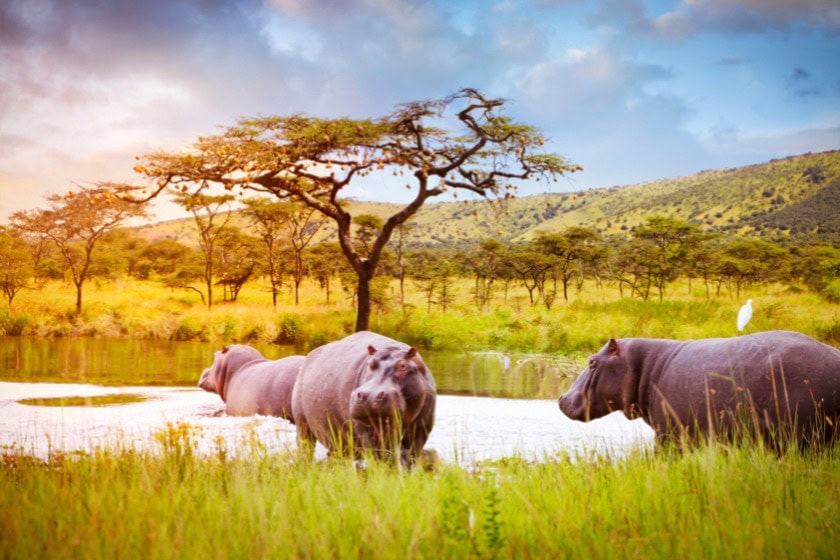Known for its safety, well-developed infrastructure, and focus on sustainable tourism, Rwanda is a comfortable and accessible destination for a photographic safari, whether you’re a seasoned pro or a budding enthusiast. The country is possibly most famous for its mountain gorilla trekking tours, a bucket-list experience for any wildlife photographer. The primate action doesn’t end there, though. Photographers can also embark on guided treks to witness endangered golden monkeys. Photographic safaris in Rwanda are exciting, to say the least!
This East African nation features lush rainforests, sprawling savannah, and volcanoes, giving landscape photographers ample opportunity to capture stunning shots. The country also boasts rich birdlife, perfect for fans of avian photography. For those interested in capturing the essence of local life, Rwandan culture is vibrant and features a variety of captivating traditions and rituals. If you’re looking for a more traditional safari experience, head to Akagera National Park to capture elephants, giraffes, and antelopes. Here are our top 5 destinations for a photographic safari in Rwanda:
1. Volcanoes National Park

Renowned for its population of endangered mountain gorillas, a safari in Volcanoes National Park is a major draw for wildlife photographers. The park offers a rare gorilla habituation experience, allowing photographers extended, immersive encounters with these incredible creatures.
Set against the backdrop of the Virunga Mountains, the park features a stunning volcanic landscape that will bring depth and beauty to your photos. Mist-covered landscapes and ever-changing weather conditions create a mystical atmosphere, lending a sense of ethereal beauty to landscape photography.
2. Lake Kivu

Lake Kivu offers landscape photographers a scenic backdrop of rolling hills and distant mountains, along with the chance to capture brilliant sunsets and sunrises reflected against tranquil waters. Photographers can look forward to exploring lakeside communities to capture the daily lives of the local people.
Vibrant markets, traditional fishing activities, and bustling villages offer rich opportunities for cultural photography. Embark on a boat safari to get a unique perspective of the shoreline, and keep your camera ready for the endemic bird species of the lake. On your boat safari you’ll get to explore islands like Napoleon Island and Amahoro Island, perfect spots for wildlife and landscape photography.
3. Akagera National Park

An Akagera National Park safari provides a rich contrast to Rwanda’s more typical lush forests and mountainous regions. Vast savannahs and open landscapes provide excellent opportunities to see and capture Rwandan wildlife, and the park plays host to the Big Five (lion, elephant, buffalo, leopard, and rhino) if you’re looking to tick them off your bucket list.
With over 500 bird species, Akagera is also a haven for avian photographers looking to capture raptors, and waterbirds amongst a range of colourful species. For a unique photographic experience, the park offers night safaris, giving photographers the chance to shoot nocturnal wildlife. All park visits are led by professional guides and rangers keen to show off the best Akagera has to offer.
4. Mount Bisoke

A dormant volcano in the Virunga Mountains, Mount Bisoke’s conical shape and rugged terrain provide a dramatic and visually stunning landscape. At the summit, there’s a beautiful crater lake surrounded by lush vegetation – a rewarding scene once you’ve hiked through the diverse flora and fauna on the trail. Mount Bisoke’s wide variety of bird species is ideal for avian enthusiasts, while macro photographers will get the chance to capture rare and endemic plants.
This destination is also close to Volcanoes National Park, where photographers can enjoy a gorilla habituation experience and capture the magnificent creatures in their natural habitat. Those interested in showcasing the cultural aspects of the region can visit the local communities at the base of Mount Bisoke.
5. Nyungwe Forest National Park

Featuring East Africa’s only canopy walkway, Nyungwe Forest National Park is home to 13 different primate species, offering wildlife photographers the ideal opportunity to capture these fascinating animals in their natural habitat. The park’s professional guides lead visitors on nature walks through the forest, providing insights into the ecosystem and highlighting photographic opportunities.
A biodiversity hotspot, the park has over 1,000 plant species. Nature photographers can see the elusive forest elephants or capture images of over 300 bird species. Nyungwe is dotted with scenic waterfalls and rivers, allowing photographers to capture cascading waters and tranquil streams amongst lush vegetation. The forest is often shrouded in mist, lending an ethereal beauty to your shots.
To add a human element to your photographic safari, you can visit the local communities around Nyungwe to capture the villagers’ cultural traditions and daily life.
When embarking on a photographic safari, it’s essential to pack the right equipment, pick the best season, and to consider hiring a guide who can show you all the hidden gems to capture. Speak to a safari expert at Discover Africa today to start planning your tailor-made photographic safari.
Author: Susan Veldman
Published:
Last Update:
Part of the Rwanda Safari & African Photo Safaris Collections